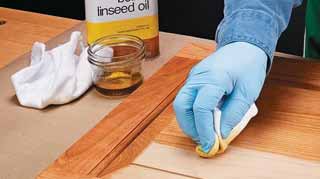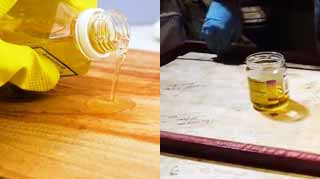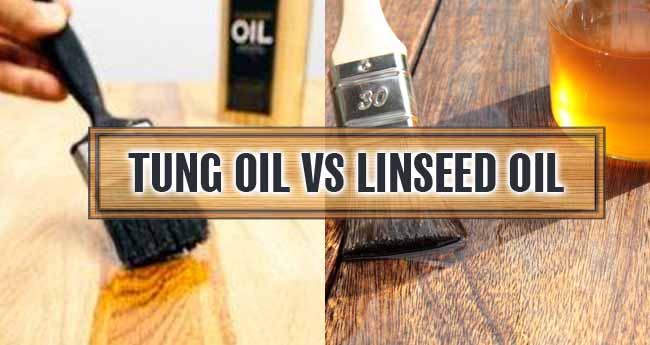If you’re looking to coat a piece of wood with a layer of protective material – then you probably found that both linseed oil vs tung oil are excellent options. But you don’t know which one to pick.
They are both natural and effective ways to finish wood. You will find that they both deliver a highly protective layer, and they both make wood look better. That’s why choosing the right one between the two is not easy.
Well, don’t worry. We’re going to help you out find out whether tung oil or linseed oil can offer what you’re looking for.
This article contains every single piece of info you want about the two. So, picking the ideal oil for your wood finishing will be a piece of cake. Take a look further to learn!
What is Linseed Oil?
You will find linseed oil as one of the most popular options for finishing wood. Also known as flaxseed oil, it delivers a saturated and deep-absorbing surface that looks neat. It also protects the wood against humidity and adds a layer of scratch-resistance coat.
What sets it apart is the unique satin finish it delivers. This adds up a shiny effect to the wood and makes it more attractive.
There are different types of linseed oil, though, and all of them deliver a wide variety of results. But they all come from the flaxseed plant, and they just go through different manufacturing processes.
Overall, linseed oil is an eco-friendly and highly reliable way to coat wood. So, it is not a type of protective coat you want to dismiss.
Advantages of Linseed Oil

We can’t explain what linseed offers without getting deep into its benefits. Here, we present why it is such a great option so you can have a much better idea of what it offers:
Beautiful Finish
The first thing you’ll notice after coating a piece of wood with linseed oil is how well it highlights the natural colors.
Linseed oils tend to offer a uniquely shiny touch to the surface of the wood that makes dark woods look super bright and light woods to become more yellow-saturated and beautiful.
If you want to give wood a nice yellowish touch on the surface, then linseed oil can be an excellent option.
Fast Application
You don’t need to apply ten coats of linseed oil on the wood surface to get the results you want. As little as two or three coats are enough to cover an entire surface and get excellent results.
Dries Fast (When Boiled)
This is only true to boiled linseed oil. It can dry in only a few hours. As boiled linseed oil has unique properties and chemicals on its composition, it dries up almost ten times as fast as its raw alternative. To be fully cured, it requires no more than one day.
Versatile and Practical
Something that makes linseed oil stand out is the capacity to work almost anywhere. You can apply linseed oil on any type of wood, and it will work wonders – whatever the color, strength, or even state of the wood.
Apart from that, linseed oil can help strengthen the wood if used correctly and may be used as a paint binder in some cases. There are many uses to linseed oil apart from just coating the surface of the wood.
Disadvantages of Linseed Oil
Yes, linseed oil is an excellent way to protect the wood. But it also has a few drawbacks. Here are a few of them:
Not for Outdoor Use
Do you need to protect outdoor furniture or an outdoor floor? Then stay away from linseed oil.
While it offers a decent waterproof capacity and leaves a protective coat, it is far from ideal for outdoor use. Because it doesn’t have chemical or heat resistance, it loses some durability, making it easier for it to wear off when used in areas that have direct exposure to elements.
Tends to Fade Over Time
While linseed oil gives a particular yellow tone to the wood at first, it tends to fade over time. Typically, the linseed looks bright and clear for the first few months. But after a year, and with tons of exposure to elements, linseed starts getting an orange tone and darker. Not everyone will like that.
Takes Time to Cure (When Raw)
In its raw form, linseed oil is one of the slowest and most annoying coats you can apply on wood.
While its boiled alternative takes a few hours to a day max, the raw version can easily take three days up to a week to cure completely.
Luckily, you can always add the chemicals and/or products to make it dry faster. But it will still not dry in less than two or three days.
What Is Tung Oil?
Also, as a plant-based product, tung oil is highly popular and effective at protecting the wood.
Tung oil dries quickly and penetrates the wood deeply. This makes it one of the easiest and most effective coats you can use.
Apart from that, tung oil is totally eco-friendly and non-toxic. Sure enough, it leaves a good-looking surface on the wood.
Similarly to linseed oil, tung oil is totally raw. However, it doesn’t have several versions like the former. So, if you find a particular version of tung oil out there, it’s likely not tung oil at all.
There are many reasons to use tung oil, and there’s no mistake why. It is a pretty easy and effective way to protect the wood, but also looks similar to lacquer and varnish. If you want to give timber a new look, tung oil can be an excellent idea.
Advantages of Tung Oil

If you want to know how tung oil versus linseed oil turns out, then you want to take a look at its benefits. Here’s how tung oil performs well:
Excellent Water Resistance
Want to protect the wood from moisture? Then use tung oil. It has fantastic waterproof properties that preserve small or large pieces of wood from any damage caused by humidity.
That’s why tung oil is such an excellent choice for outdoor furniture and other products. At the same time, it works wonders for dishes, cutting boards, bowls, and similar items.
Dries Fast
The raw and original version of tung oil dries outstandingly fast. There’s no need to add additives or any extra chemical to tung oil, it will penetrate the grain and dry up in a few hours with ease.
To let it cure, you won’t have to wait more than a day. In some cases, twelve hours is enough for tung oil to cure entirely.
Attractive Color
If you get tung oil that doesn’t look like honey with a slightly yellow but transparent finish, then that’s not tung oil.
This semi-clear honey-like tone makes the wood look beautiful. From dark to light woods, they get an amber tint that surpasses expectations in quality. Sure enough, this honey-like touch also gives more brightness to the wood.
Sturdy and Durable Finish
Because tung oil protects the surface from water, it is also more likely to never grow mold, rot, or soften up. But the real advantage comes from how strong it makes the wood in the long term – preventing splits, cracks, and warps.
If you want to give a durable finish to any piece of wood, then tung oil can be an excellent choice. The flexibility and strength it offers are simply unique.
Disadvantages of Tung Oil
It is safe to say that tung oil is impressive. But it is not perfect. Here are some of the ways it loses appeal:
Challenging to Apply
One of the main differences between boiled linseed oil vs tung oil is how different the application is.
With standard or boil linseed oil, you won’t have to make much of an effort to apply. Two or three coats will be enough to provide a flawless finish. And sanding will give the necessary smoothness.
With tung oil, this doesn’t happen. You will have to cover the wood with at least five layers for it to stay neatly and protect well enough. At the same time, it demands more sanding and preparation afterward if you want a stunning finish.
Highly Expensive
In contrast with linseed oil, you won’t find tung oil too cheap. In fact, it is one of the most expensive plant-based oils you can use to coat wood.
This happens because it is harder to extract. At the same time, it is thicker and has more potent molecules, which makes it a more expensive product overall.
Linseed Oil vs Tung Oil: Which One to Pick?

It is safe to say that both tung oil vs linseed oil are excellent options. They’re both non-toxic and environmentally safe. And sure enough, they provide excellent results on wood. But one of them is clearly better in most aspects.
That would be tung oil. Not only because it is a little more durable but because it doesn’t fade over time as linseed does.
Don’t get mistaken, though, linseed oil is still an excellent choice. But it doesn’t produce the same long-lasting or resilient result that tung oil does.
At the same time, however, tung oil is far more expensive. So linseed oil would be the clear budget choice.
Concusion
Overall, it all comes down to what you want. If you care about quality over anything else, then tung oil is your best bet. But if you’re short on budget, linseed will deliver decent-enough results. Choose accordingly.
- How to Choose Wood Filament: A Complete Guide - July 17, 2021
- 10 Best Propane Forge Reviews - June 30, 2021
- Best Circular Saw Blade for Plywood : Top 10 Picks - June 30, 2021



I found the article very informative and helpful I now know the difference between boiled linseed oil and tung oil and which one tom use
It is totally my pleasure.
What happens if you mix the linseed with tung, or, can you apply one over the other? Your thoughts please. Thank you.
Yes, you can mix them. 🙂
Excellent article! I have some questions, however. My home came with a partial gallon can of Spencer Kellog’s Pure Raw Linseed Oil. It is still in a liquid form. I am wondering if the product is still good? (I’ve also noticed the same product for sale on Ebay.) Should I move it to a different container? Can it be mixed with another brand of pure linseed oil? I’m considering using it to refinish one of my hardwood floors.
Addendum info… the can appears to be pre-Textron.
As long as it wasn’t stored in the sun in a glass jar, which you say it was note, it should still be ok. I’ll guess that it should be fine for most uses. It is not necesary to move it to another container.
on the cremation urns I create I have been using BLO and they have been turning out great, however, after your article, a question came to mind. What’s your opinion about using paste wax to help the durability of the finnish. I don’t see them after they leave my shop so I don’t have a long-term reference point. Thanks,
Hello,
In my opinion there is no reason to apply paste ewax over BLO. In some cases adding paste wax may even ruin the finish.
On our ranch in SD, in 1959-1967, we used boiled linseed oil on our hay wagons, feed bunks, and hay feeders. Each item got two applications at four-year intervals. These implements haven’t been re oiled in over 55 years, yet they are nearly as sound as when they were new. They’ve darkened from 60 years of rain and mildew.
For over 20 years, I’ve been using boiled linseed oil on older, previously stained wood fascia, vigas, beams, windows, and even doors. For door and ornamental features, we oil joints, cracks and voids in the finish; then usually apply the appropriate top coat.
In the Phoenix area, about 2% of any exterior structural wood can begin to decay in less than 15 years. Tops of beams are particularly vulnerable. We found serious decay 2” deep and 18” long in the top of a 17-year-old, 3”x7” glue laminated beam. We removed the decay, treated the area, and drilled holes out the side of the beam so rain can drain.
Linseed oil and wood preservative arrest decay and will likely send exterior wood into the next century and beyond.
Lyn Parrott, Wood Rescue